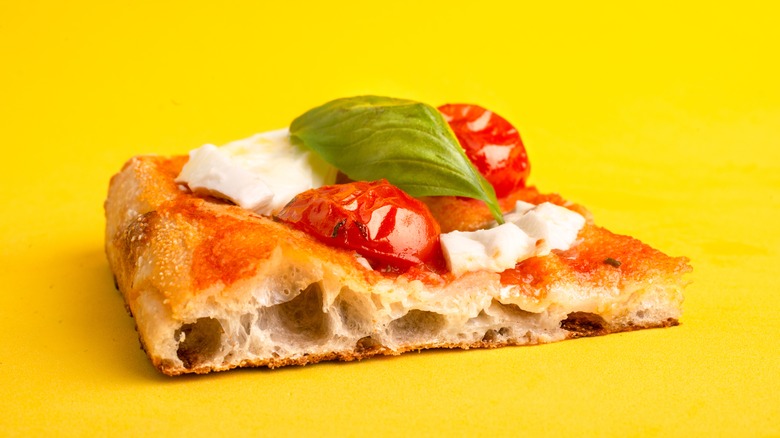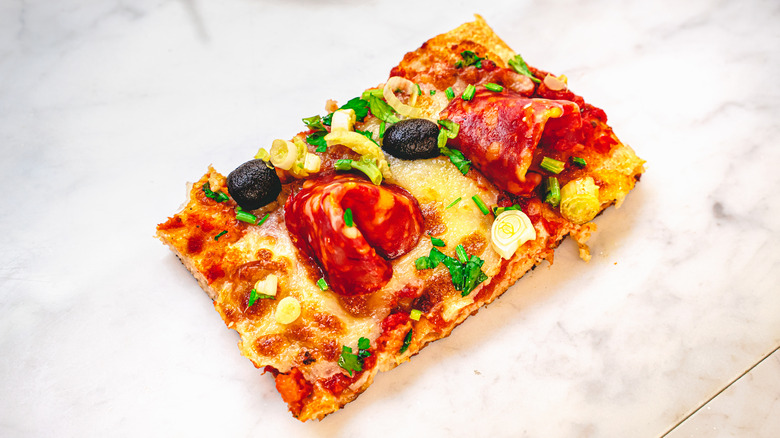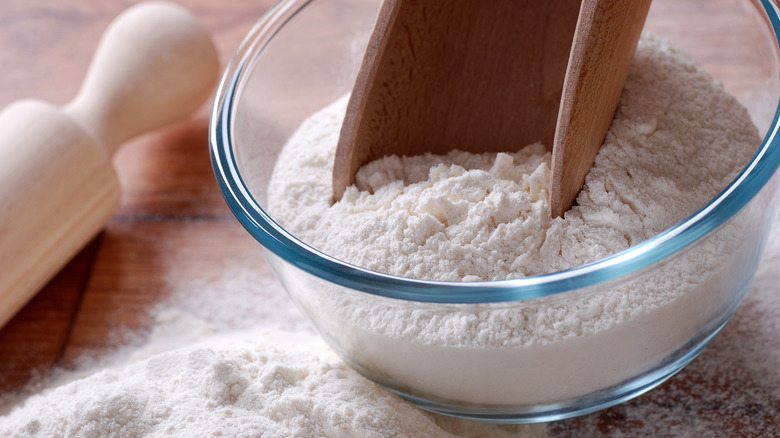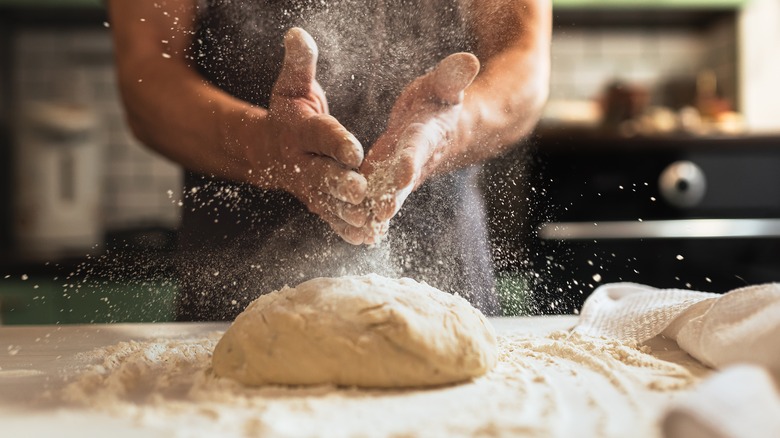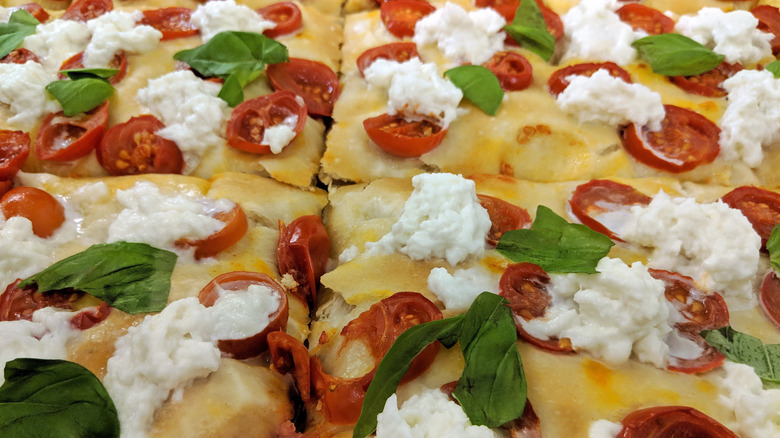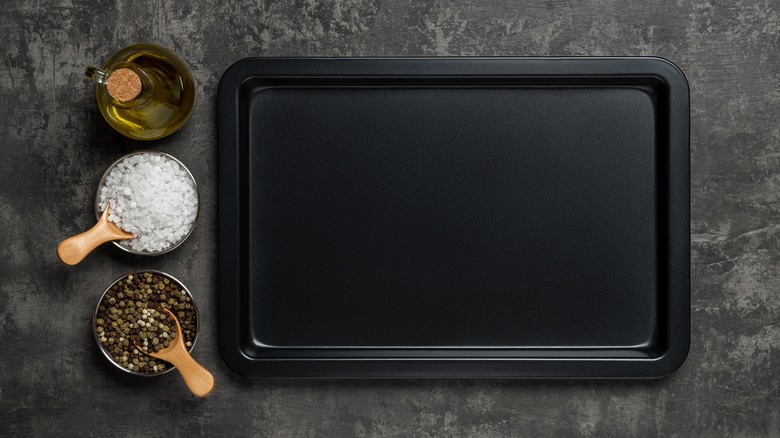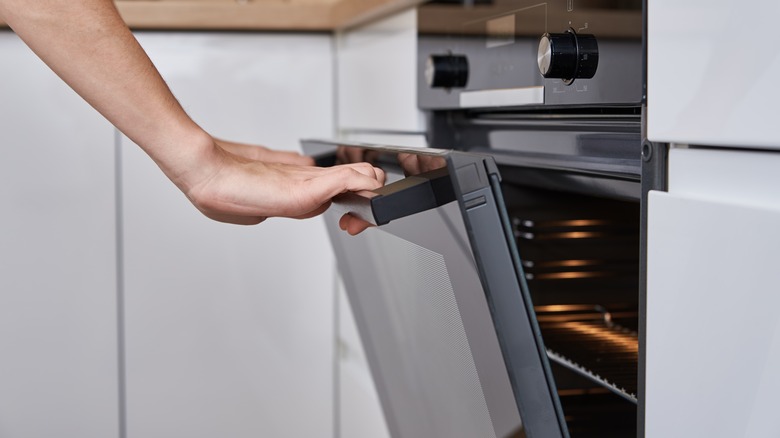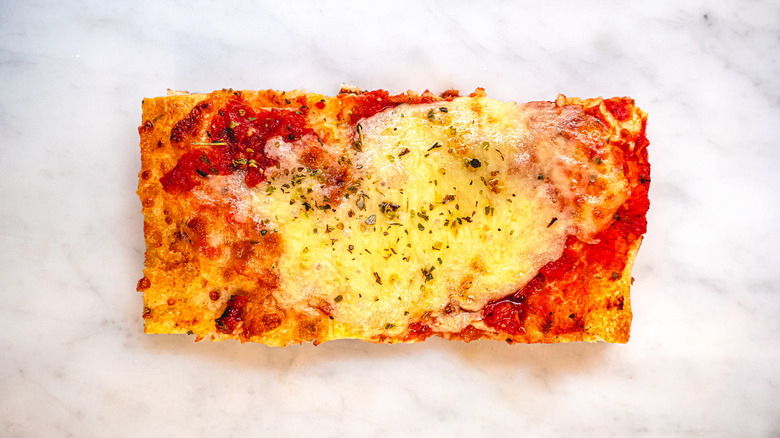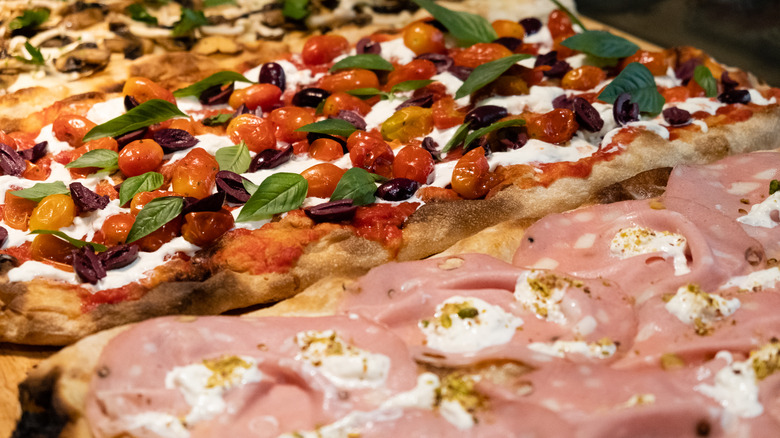Facts You Should Master About Roman-Style Pizza
Pizza is the go-to fast food for millions of people worldwide; in the U.S., it remains as popular as ever, with pizza restaurants across America raking in over $45 billion in 2021, per Statista. With sales like that, it's clear that this food is here to stay. When we think of pizza, we often envisage circular pies with curving crusts, cooked rapidly in a white-hot oven and cut into wedges.
But a different style of pizza is starting to gain popularity in the United States, with more and more people discovering Roman-style pizza or pizza Romana. Created with a distinctive rectangular shape, a long-fermented dough, and specific cooking requirements, "Roman-style pizza — which is also called 'pizza al taglio,' 'pizza alla pala' or 'pinsa' — is lighter, easier to digest and above all, crunchy (which Americans love)," states pizzaiolo and Roman Pizza Academy founder Massimiliano Saieva, via La Cucina Italiana. We wanted to dive deeply into this pizza style to find out exactly how it's made, so grab a slice, and let's get started.
What is Roman-style pizza?
To delve into the facts about Roman-style pizza, we first have to figure out what it is. And that's not easy when "Roman-style pizza" could refer to several pizza varieties. "In Rome there are multiple pizza styles that are distinct to the city and are recognizable to locals and people from other regions as uniquely Roman," states Katie Parla, a food writer based in Rome, via Los Angeles Magazine.
Generally, when people refer to a pizza as being Roman-style, they typically mean pizza al taglio, which can be translated to "pizza by the cut" (per Tasting Table). Pizza al taglio is traditionally a rectangular-shaped pizza cooked in a long pan and adorned with a variety of toppings. Instead of being cut into triangular slices, the pizza we know as Roman-style is then usually separated into rectangular or square pieces, with the diner specifying exactly how big they want their piece to be (we like the sound of that!). Another style of pizza commonly found in Rome, known as pizza tonda, generally has a much thinner crust and is served in the classic round shape, Mortadella Head says.
In America, Gabriele Bonci is a pioneer
If you mention this type of food to anyone who knows their pizza, it likely won't be long before they bring up Gabriele Bonci. The famed Roman pizzaiolo became a sensation in Italy for serving pizza al taglio at his restaurant Pizzarium. It was soon championed by the late Anthony Bourdain, per Restaurant Business. Bonci later set his sights on the United States — the pizzaiolo now operates new additions in Miami and Chicago and maintains his original Italian restaurant, Bonci USA states.
Bonci exhibits a clear passion for pizza and states that he seeks to create his food without cutting corners or using low-quality ingredients. And his pizza is about as Roman-style as you can get, with a focaccia-like dough and slices served by weight. But the sheer creativity of his recipes sets him apart from the rest. "Bonci has 2,500 recipes. He's out there. Now, we use about 300 of his recipes. We do octopus and smoked salmon ... Chicago has a meatball pizza. New Orleans got muffuletta and an oysters Rockefeller pizza," states Rick Tasman, the president of Bonci USA, to Restaurant Business. "We haven't done tripe yet," he adds. Well, never say never, Tasman.
Good ingredients are vital
Any chef will tell you that to make good food, you need good ingredients. And that rule is no different when it comes to Roman-style pizza. Making a quality Roman-style pie starts with your dough's ingredients, Roman Pizza Academy founder Massimiliano Saieva expresses to La Cucina Italiana. The pizzaiolo notes, "you need to start with a good Italian flour, a great Italian olive oil, a good oven (which can reach up to a 600°F degree temperature), and dry yeast," Saieva states.
If you're planning on trying out Roman-style pizza at home, 00 flour is the way to go. Also known as doppio zero flour, 00 flour is particularly finely ground, with the numbers in its name referring to its small grind size, says MasterClass. One of the reasons 00 flour is so well-suited to making pizza is its exceptionally high protein content, which gives it an elastic texture that's perfect for kneading and shaping without the pizza becoming too tough or chewy. While 00 flour may appear similar to all-purpose flour at first glance, there are key differences, with the latter generally having a much higher gluten content.
The preparation of the dough is unique
The toppings on a pizza may give it its star appeal, but if you don't have a quality crust for your foundation, things can fall apart quickly. And when it comes to Roman-style pizza, how the dough is made is crucial. As Thrillist discusses, Roman-style pizza dough is distinguished by its exceptionally high water content, creating a moist dough that's then fermented over several days. What's particularly interesting about Roman-style pizza dough is it undergoes a cold fermentation process instead of being allowed to ferment at room temperature. By keeping it in a cold environment like the fridge, the gluten proteins are broken down regularly while the fermentation process is slower. Essentially, this means that when it comes to taking it out of the fridge to cook, it's lighter and more aerated after a fermentation process that can take up to four days.
This aeration is contributed to by the high water content, which gives the dough more air bubbles (also known as a "honeycomb"). The result, once cooked, is pretty unique. "You think, There's no way this can taste better than it looks. But it actually does. It's like eating air," says Roman Pizza Academy co-founder Alex Manzo, per Thrillist.
Roman-style pizza can often be confused with other Italian staples
While Roman-style pizza in the style of pizza al taglio is becoming prominent in the United States, it can still be confused with other Italian pizza-related dishes. At first glance, the pizza can easily be mistaken for topped focaccia, largely thanks to their similarities in shape. There's a key difference, however. Despite both foods being baked in rectangular pans and frequently cut into smaller, more manageable pieces, focaccia is left to proof in the tray that it's eventually cooked in, whereas Roman-style pizza proofs elsewhere and is then shaped into a rectangle, as MasterClass discusses. This proofing process makes all the difference, and in Roman-style pizza's case, contributes to its eventual crispy crust.
Roman-style pizza can also often be mistaken for pizza tonda" — and to be fair, that's not entirely incorrect. Both styles of pizza originate from Rome, and pizza tonda does indeed fall under the classification of a Roman-style pizza but is different from the pizza al taglio that you might find a little more easily in the U.S. Pizza tonda is characterized by having a super-thin, almost snappable crust, in a pizza that's flat and round, according to Eataly.
The shaping of the pizza is crucial
A good pizza is nothing without visual appeal, and Roman-style pizza has that in spades. The pizza style is unique in terms of visual presentation in its shape, which is rectangular, baked in long pans, and then sliced into pieces. This arguably stemmed from the increasing popularity of the electric oven, the shape of which suited rectangular pizzas, according to Tasting Table.
And instead of shaping the dough and placing it on a pizza stone, with Roman-style pizzas, the dough is shaped directly into the pan, as La Cucina Italiana states. After the dough has fermented and leavened fully, it's transferred to a floured surface or baking pan, separated into buns, folded, and allowed to rise again for several hours. Once this is done, bakers take a lightly oiled pan, create a rectangular shape with the pizza on another surface that's almost precisely the shape and size of the pan, and then transfer the dough into it. When the dough is in the pan, it's nudged into shape, adorned with the toppings of your choice, and then thrown into the oven. Remove, slice, serve, and enjoy.
Keep your heat high at first
It's no secret that pizzas take a lot of heat to cook, and Roman-style pizzas are no exception. What's interesting, though, is that the cooking heat, style, and time, are all slightly different from other types of pizza. When cooking a Roman-style pizza, chefs use a dual-heat process: They start by placing the pizza in its sheet pan in the hottest possible oven for six minutes on the lowest shelf, La Cucina Italiana states. After this, the pizza is moved higher in the oven to the middle frame while the temperature is knocked down to 230 degrees Fahrenheit. At this point, cheese is usually added to the pizza, which is then allowed to cook for 10 minutes before the dish is ready to take out.
It's worth pointing out that other Roman-style pizza recipes dispense with this second heat step and keep their heat high throughout the cooking process, as MasterClass shows. The latter method is closer to a classic Neapolitan-style pizza, which is generally cooked in an oven of 500 degrees Fahrenheit (or even higher in some kitchens) on a pizza stone. Nonetheless, one thing's clear with Roman-style pizza: Things will get hot quickly.
Don't go wild on the toppings
What's a pizza without toppings, people? While we're fully ready to admit that a simple Marinara pizza is a thing of beauty, we definitely believe that nailing your toppings combo can take your 'za from good to great. When it comes to Roman-style pizza, though, it's important to strike a balance. Although it can be tempting to throw on everything we can think of, putting too many toppings on a Roman-style pizza can alter how effectively the dough bakes, and the result can be a soggy, dense affair, as MasterClass says.
The perfect Roman-style pizza uses toppings judiciously, with the additions evenly distributed across the pie while leaving space for the dough to cook underneath. Like other pizzas, it's vital that high-quality toppings are used to ensure the best flavor and experience. Where you can go wild, though, is on your topping combos. One of the best things about Roman-style pizzas is how diverse their toppings can be. In a Roman-style pizzeria, you'll find anything from a simple cheese and tomato to a pizza with potato and even pizzas with speck, pumpkin, and caciocavallo on them, per Bonci USA. Excuse us while we find one of these restaurants right now.
Once it's ready, let it cool
While it might be tempting to consume Roman-style pizza straight out of the oven, true pizza al taglio aficionados know that there's one essential step before it can be enjoyed: the cooling process. Once out of the hot oven, Roman-style pizza is allowed to cool on a wire rack a little before it's dished up to customers, as La Cucina Italiana communicates. This is to allow any excess moisture to seep out from the pizza, ensuring it remains crisp before serving.
And how is it served, you ask? Well, there's a specific process for that too. In Roman pizza restaurants, the pies are generally displayed behind glass counters instead of being cooked separately to order, says MasterClass. Then, customers tell the pizzaiolo which one they want and how much they'd like (usually determined by weight), and they cut off a slice using pizza scizzas. These scissor-like contraptions keep the integrity of the pizza intact, per Tasting Table. The pizzaiolo then wraps it up in a paper bag, and the customer is free to stroll through the streets of Rome with their pizza, munching as they go.
